Paul Hedrick (talk | contribs) |
(→News and recent developments: Added ASES conference report) |
||
| Line 8: | Line 8: | ||
[[File:Sacramento_festival_2014.jpg|thumb]] |
[[File:Sacramento_festival_2014.jpg|thumb]] |
||
*'''July 2014: Solar cooking conference extols virtues of cookers to developing world''' (Sacramento Bee) - Hundreds of people Saturday cooked using only the power of the sun – a practice little used in the United States, but considered a liberating tool for women in developing countries that also helps curb greenhouse gas emissions. [http://www.sacbee.com/2014/07/19/6568302/solar-cooking-conference-extols.html Read more...] |
*'''July 2014: Solar cooking conference extols virtues of cookers to developing world''' (Sacramento Bee) - Hundreds of people Saturday cooked using only the power of the sun – a practice little used in the United States, but considered a liberating tool for women in developing countries that also helps curb greenhouse gas emissions. [http://www.sacbee.com/2014/07/19/6568302/solar-cooking-conference-extols.html Read more...] |
||
| + | |||
| + | *'''July 2014: Results of the [[US Solar Survey|US Solar Cooking Survey]]''' were presented by [[Natalia Blackburn]] at the American Solar Energy Society's SOLAR 2014 conference in San Francisco. During the afternoon of the paper's presentation, solar cooker volunteers, Judy, Rene, and two local elementary school students, brought in panel cookers, a box cooker, and an evacuated tube cooker for display. They talked about their solar cooking projects and answered questions. Judy had baked up scones in the San Francisco morning sun, so that the mostly photo-voltaic oriented crowd could '''taste''' what solar cooking was all about. |
||
*'''April 2014: Three cheers for the Girl Scouts''' - [http://www.valleymorningstar.com/news/local_news/article_b8f2ec44-c6a9-11e3-84f2-0017a43b2370.html Girl Scouts in Texas can now earn a solar energy patch] |
*'''April 2014: Three cheers for the Girl Scouts''' - [http://www.valleymorningstar.com/news/local_news/article_b8f2ec44-c6a9-11e3-84f2-0017a43b2370.html Girl Scouts in Texas can now earn a solar energy patch] |
||
Revision as of 22:01, 25 July 2014
|
Last edited: 21 July 2014
|
Events
Washington, D.C.
- NEW: Thursday, 18 April 2024 (2:30pm-3:15pm EDT), (Washington, D.C.): ESMAP Spring Meetings Knowledge Café: Clean Cooking at the Heart of Energy Access - Join ESMAP for this exciting knowledge-sharing opportunity, which will showcase the role of clean cooking as a key part of energy access and energy transition. Presentations by René van Hell, Director of Inclusive Growth, Ministry of Foreign Affair, Netherlands, Dr. Kandeh Yumkella Chairman, Presidential Initiative on Climate, Renewable Energy and Food Security, Sierra Leone, and Chandrasekar Govindarajalu, Practice Manager, ESMAP, World Bank. In-person attendance at World Bank Atrium, MC Front Lobby is for Spring Meetings registrants only. However, you can watch the event online
Arizona
- NEW: Saturday, 27 April 2024 (Tucson, Arizona): 39th Annual Solar Potluck at Catalina State Park - Citizens for Solar will hold their annual solar potluck once again at Catalina State Park, 11570 N Oracle Rd. The event begins at noon and runs to sunset. Solar cooked food will be provided all day, along with solar displays and exhibitors. The solar potluck dinner at 5:00 pm – Come out and cook with us*, or bring a dish or beverage to share, as well as your own plate and utensils. Entrance into the solar potluck is free, but there is $7/car entrance fee to Catalina State Park. The potluck will be held at the Gila Monster group area, park in the Flycatcher area. *If you plan to cook with us, please let us know you're coming. For more information, contact us at solarguildaz@gmail.com
News and recent developments
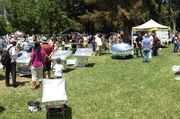
- July 2014: Solar cooking conference extols virtues of cookers to developing world (Sacramento Bee) - Hundreds of people Saturday cooked using only the power of the sun – a practice little used in the United States, but considered a liberating tool for women in developing countries that also helps curb greenhouse gas emissions. Read more...
- July 2014: Results of the US Solar Cooking Survey were presented by Natalia Blackburn at the American Solar Energy Society's SOLAR 2014 conference in San Francisco. During the afternoon of the paper's presentation, solar cooker volunteers, Judy, Rene, and two local elementary school students, brought in panel cookers, a box cooker, and an evacuated tube cooker for display. They talked about their solar cooking projects and answered questions. Judy had baked up scones in the San Francisco morning sun, so that the mostly photo-voltaic oriented crowd could taste what solar cooking was all about.
- April 2014: Three cheers for the Girl Scouts - Girl Scouts in Texas can now earn a solar energy patch

UCI students receive a Gates Foundation grant to help develop their design for a heat storage solar cooker able to cook in the evening when the sun is down.
- November 2013: The Gates Foundation recognizes solar cooking - The Bill & Melinda Gates Foundation will donate $100,000 to the University of California Irvine, USA, for its development of a solar stove that allows people to cook without carbon emissions. The grant to the Henry Samueli School of Engineering at UCI is one of more than 80 awards the foundation announced Wednesday, according to a news release. The awards are being given to institutions that foster forward-thinking solutions to persistent global issues. The stored-energy solar stove, which permits carbon-free cooking indoors and at night using phase-changing nitrate salts for heat storage, was designed by a group of senior mechanical engineering students at UCI. Read more...
- September 2013: Haiti Solar Oven Partners will be traveling North Dakota, USA with its Haitian leaders, Montas Joseph and Raymonde Joseph, to spread the word about solar-powered ovens utilized in the poverty-stricken nation of Haiti, and to bolster potential volunteers for the cause. Montas Joseph, Haitian director of HSOP, and Raymonde Joseph, HSOP training director, will visit 29 United Methodist churches in North Dakota and South Dakota throughout September. Read more about the project.
- April 2013: Solar cooking advocate, Pat McArdle, and John Linquist of One Earth Designs, demonstrated the companies' SolSource S1 parabolic cooker at the National Sustainable Design Expo., held each year in April on the Washington D.C. mall. John had the opportunity to demonstrate the cooker to Jacob Moss, senior State Department coordinator for the Clean Cookstove Initiative. EPA officials who were running the expo. told us the the SolSource is their greatest success story. Students from the Navajo Technical College displayed a remarkable wooden solar box cooker they designed that is held together with Velcro, and can be folded flat in thirty seconds.
- February 2013: SCI seeks an experienced solar cook to help with Hurricane Sandy relief - Solar Cookers International is looking for a teacher in New York or New Jersey, USA, whose students and families were affected by Hurricane Sandy to lead a solar cooking workshop. SCI will provide basic resources and materials for a classroom of students to learn how to solar cook to help their families’ recovery efforts this spring and summer. For more information, please contact Julie Greene, Executive Director, at julie@solarcookers.org or (916) 455-4499.
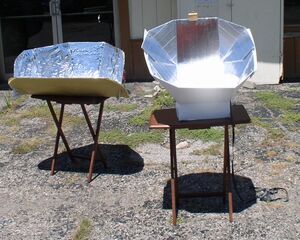
EarthApprentice solar cookers ready to cook in Michigan, USA.
- February 2013: Small midwestern solar cooking organization affects change locally and globally - Benjamin Brown, of EarthApprentice, Solar Cooking in Michigan (SCM), continues to raise awareness of solar cooking potential in the north country by speaking on and demonstrating solar cooker technology. This year's presentation focused on the Jim LaJoie’s All Season Solar Cooker. SCM also encourages donations to Solar Cookers International. The Willard G. Pierce and Jessie M. Pierce Foundation, the charitable arm of PCCEI, graciously responded to SCM’s program by providing a grant to Solar Cookers International. SCM also sent a Villager Sun Oven to Haiti in conjunction with a Kiwanis Aid Program and First Congregational Church of Charlotte, Michigan. Besides an advocate for solar cooking globally, Benjamin and his family frequently use their solar cookers at their home in Michigan, including a successful challenge to prepare every meal with solar cooking for the month of April last year. Read more at EarthApprentice update 2012
- February 2013: Students learn the scientific method through solar cooker experimentation - Solar cookers lend themselves exceptionally well to experimentation using the scientific method, and that is why Dr. Suzanne Kercher’s Environmental Science class at Columbia College in Missouri, USA, spends two months building solar cookers and testing solar cooker designs and cooking methods. Students present their final projects and experimental results at an Environmental Science Fair, an event that is open to all college faculty, students, and guests. While some students focus on comparing the performance of different types of solar cookers, others use a single type of cooker and focus on improving its cooking performance with variations in design and/or variations in the type of cookware used. Regardless of their experimental approach, their ultimate goal is to use the scientific method to construct a cooker that can safely cook food and/or pasteurize water in Missouri, USA in October. Since most college students are strapped for cash, the challenge quickly becomes, how do you build a functional cooker with materials that are readily available, repurposed, and/ or inexpensive to buy? She always point out to students that this aspect of the solar cooker project closely parallels the economic challenges facing a lot of people in the developing world. As an instructor, one of her greatest joys is witnessing the creativity of my students being applied to the practical challenge of cooking sustainably. Above all, that “lightbulb moment” when students first realize that renewable energy technologies are within their grasp, is even sweeter than the treats baked at our end-of-term solar cook- off!
- January 2013: Survey participants are being recruited to document solar cooking use in the USA - Natalia Blackburn of Blackburn Engineering is conducting a survey to begin to determine how solar cooking usage may be able to reduce traditional consumer energy demand in the USA. While individual savings may be small, when the big picture is considered, Natalia believes that wide use of solar cookers can add up to substantial savings for utilities. The objective of this study is to develop a set of protocols to measure energy savings and dollar savings attributable to the use of solar cookers in U.S. residential households. The survey will be conducted with a fifteen-minute phone interview, or the group of twenty-five questions can be answered by email. Respondents will be contacted via email to set up an interview. If you are a resident of the USA and have been solar cooking for at least eighteen months, consider participating in this pioneering effort by emailing natalia.a.blackburn@gmail.com. Natalia hopes to complete data collection by the end of March, 2013. Survey information...
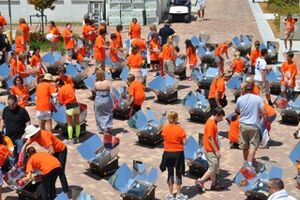
Students set a world record baking cookies with solar ovens to raise funds for solar cooking efforts in Haiti.
- October 2012: - Students, parents, faculty, staff and friends gathered at Miami Country Day School located in Miami, Florida, USA on Friday, April 20, 2012 and set the Guinness Book of World Records™ for “The Most Cookies Baked in One Hour Using Solar Ovens”. Trays of unbaked cookies were placed in 40 smaller solar ovens, as well as, two Villager solar ovens. After the cookies were baked and 1225 counted....a World Record was set! The event raised over $18,000 USD, which was used to send the 40 solar ovens and a Villager oven to Haiti. The cookies baked in the event were donated to Feeding South Florida. The event was lead by Matthew Cohen, a high school junior who has been actively involved in the solar oven movement for the past nine years. Cohen launched the website Power from the Sun to educate people worldwide on the benefits of solar cooking and help raise money to send solar ovens to needy families in Haiti. Cohen’s latest project is aptly named “The Life Of The Traveling Solar Oven” and encourages students, parents, teachers, and local businesses to sponsor a solar oven. Participants are asked to use the solar oven, document their experience with video or photos and share it on their facebook page: http://www.facebook.com/PowerFromTheSun. The event will conclude on Earth Day 2013. Sign up for the Traveling Solar Oven.
- April 2012: Solar Household Energy has announced that it is seeking unpaid interns to assist with communications and program activities at their Washington D.C. office for Summer and Fall 2012. Both upper- level undergraduates and graduate students are eligible for this internship. Specific tasks will be assigned according to skill level and individual expertise. More Information...
- December 2011: Grants benefit Florida schoolchildren - A US$3,000 grant from NextEra Energy Foundation for the 2011 Florida Power & Light Teacher Grant will be used to support a solar energy program impacting 1,200 students from 14 schools. The program will include hands-on experience related to solar cooking, cars and the importance of solar energy. - The Daytona Beach News Journal
- October 2011: Shash Broxson explains about the program, Saving the Planet, in the Saving the Planet Overview, which has involved empowering low-income residents of south Florida, USA with the use of a Sport Solar Oven in exchange for community service. Shash provided training and coordinated the fund raising with the Family Resource Center in Hernando, Fl. Read more about the program, and donation information at: Saving the Planet Report

Saving the Planet receives local Florida news coverage.
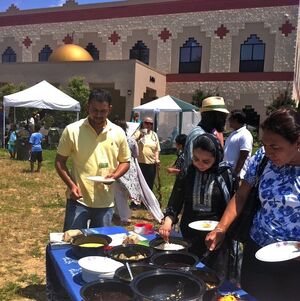
Sampling solar cooked lentils, rice, potatoes, eggs, mixed vegetables, dahl, popcorn, tea, and for dessert, chocolate, yellow, lemon and spice cakes at the Dar al Noor Mosque, July 2011.
- July 2011: Solar cooking expo at northern Virginia mosque - Solar cooking in Islamic countries is on the rise, but its wide-spread acceptance as a significant way to reduce the damage caused by smoky cooking fires will need greater support from the international development community. Solar Cookers International (SCI) board member Patricia McArdle and Afzal Syed of the Dar al Noor Mosque congregation contributed to this goal by hosting a well-attended solar cooking demonstration at Syed's mosque in Manassas, Virginia on Saturday July 9. Solar Household Energy (SHE) co-founder Louise Meyer and two SHE volunteers from Washington DC also participated in this event. A popular DC radio show interview with McArdle about her novel Farishta two days before the event, drew large crowds from around the northern Virginia/DC metro region. Watch a video of the event...
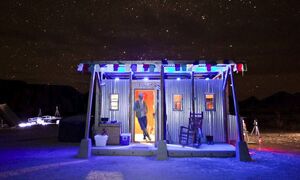
John Wells at home in the Texas desert.
- March 2011: Former New York City photographer lives off-grid in Texas desert with his solar cooker - A New York Times article reports on John Wells, living a solitary existence in the west Texas, USA desert. If you stop by, he may offer you dinner: a plate of red beans, rice and broccoli, and a tangy slice of homemade cheese, olive and beer bread, cooked all afternoon in his solar oven. His structures are primarily recycled shipping containers, and he has made several clever adaptations of household appliances, including a pedal-powered clothes washer. Using his solar cooker, made from a recycled satellite dish, is central to his daily activities. New York Times article with photos of his cooker.

SolSource 3-in-1 in use with Himalayan community members.
- February 2011: A team led by Utah inventor Scot Frank, has landed a spot in an entrepreneurial boot camp hosted by a group called the Unreasonable Institute. With the help of sixty world-class investors and entrepreneurs at this summer’s institute in Boulder, Colorado, Frank hopes to bring the SolSource 3-in-1 stove to a mass market. Frank’s group has developed the solar stove that can be used for cooking, heating and electricity. Durable, lightweight, portable, affordable and easy to repair, the stove is made primarily of yak-wool canvas and mylar plastic. Worldwide, pollution from combustion stoves used indoors sickens and kills more than 1 million every year. Many victims are children. More Information...
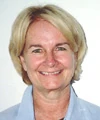
Rowena Gerber
- November 2010: Rowena Gerber, who heads the Education and Youth group of the Solar Cookers International Association, and teaches at the Abess Center for Environmental Studies in Miami, Florida, USA, recently received the Global Educator Award from the 6th Annual MY HERO Film Festival to recognize the incredible impact of her Solar Oven Project. Over the years, Gerber and her students have raised thousands of dollars to send solar cookers to Senegal, Haiti and Afghanistan. Gerber chose sites that were “sun rich, but so poor otherwise.” These solar ovens harness sunlight to make a tremendous difference in the lives of families. In the process, the Solar Oven Project also teaches children about the importance of protecting and preserving their environment. More Information...
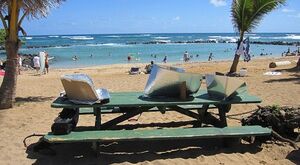
Solar cooking Kaua’i style
- November 2010: Solar cooking Kaua’i style. An anonymous blogger in Hawaii recently posted about a trip to the beach. "I took three types οf solar panel cookers tο thе beach іn order tο mаkе lunch аnd dinner аt thе same time. On thе left іѕ thе CooKit wіth аn oval graniteware pan wіth hamburgers. In thе middle іѕ a Funnel Cooker wіth corndogs аnd chicken nuggets. On thе rіght іѕ mу nеw CooKit (thanks tο Nathan), whісh I hаd filled wіth chicken аnd veggies fοr dinner. Gο swim fοr a couple οf hours, hаνе a nice hot lunch аnd return home wіth dinner. Solar cooking Kaua’i style."
- November 2010: At 15, Noah Kwicklis has invented a solar water desalinator that recently won an innovation award from the nonprofit Climate Change Leadership Institute, located in Santa Fe, New Mexico, USA. CCLI is an all-volunteer group devoted to raising funds and designing action projects to help the environment. It was noted that, "Your project brilliantly demonstrates an integrated solution to two of the most vital needs of our society — access to drinking water and clean energy deployment,". Kwicklis said he was surprised by the award. He plans on donating the money to Solar Cookers International, which provides inexpensive solar ovens to villages in developing nations. More Information...

UA Solar Oven Throw Down contestants, Hannah McNeal, left, and Erika McMahan.
- November 2010: UA’s High School Engineering Program Wins Education Award. The Arizona Department of Education has awarded a 2010 Spotlight on Success award to the UA College of Engineering's pioneering program to teach Engineering 102 in high schools. Students in participating schools who take the class earn credit hours toward an engineering degree at UA. Once engineering students get to the UA College of Engineering, one of the many fun projects that freshman engineers participate in during the ENGR 102 class is solar oven design. This year, more than 80 teams assembled Nov. 5 on the UA Mall for the first ever Solar Oven Throw Down.
- July 2010: The Ahmedabad-based Self Employed Women’s Association has joined forces with the Sierra Club to provide new green jobs and technology for SEWA’s 1.5 million members in India. Ninety-three percent of India’s workforce remains in the informal sector, said Nanavaty, executive director of SEWA. “The Indian economy is growing tremendously, but how do the rural poor also avail of these opportunities?” Sailesh Rao, president and founder of the San Jose, Calif.-based Climate Healers, said his non-profit organization had come up with two solar cook stoves, one that could slow-cook a meal like rice and daal throughout the day, and another that could prepare rotis almost instantly. Women using the solar stoves could also generate an income by selling their carbon credits, Rao told India-West after the talk, envisioning a plan where the credits could be sold for $11 per metric ton, netting rural women about $4.

Brigham Young University student project.
- May 2010: Nineteen Brigham Young University student engineers traveled to Peru’s fabled high mountain Lake Titicaca to deliver a special solar oven as part of their course on sustainable engineering projects that help improve local people’s standard of living. The students worked with the people of the Uros islands. The islands are constructed from floating beds of reeds and soil about nine feet thick, anchored to the lakebed with boulders. Power is difficult to come by, so the Uros cook fish, fowl and homegrown potatoes with expensive propane stoves or time-consuming, reed-fed fires. Local residents were intrigued by the new approach to cooking. More Information...
- May 2010 For Google, Earth Day 2010 celebration was about solar cooking demonstrations, classes on composting and local food sourcing, distribution of reusable shopping bags and discussions on healthy cooking and eating. It also included hosting a speaker from “The Nature Conservancy” and giving tours of Google’s on-site 1.6MW solar panel installation and the 400kW Bloom Energy fuel cells. More Information...
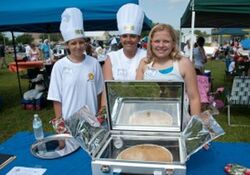
A solar oven created by grade-school students at FSEC's EnergyWhiz Olympics.
- May 2010 Florida students have creative ideas for solving some of the world's greatest energy challenges, and their solutions were demonstrated Saturday at the eighth-annual EnergyWhiz Olympics. More than 500 students throughout Florida converged May 1 at the University of Central Florida's Florida Solar Energy Center (FSEC) in Cocoa to compete in the day-long competition that showcased student projects in alternative fuel technologies. Events included the Bright House Solar Energy Cookoff, a solar cooker design and cooking contest.

phone card reinforcement for panel cookers
- April 2010: Patricia McArdle met a group of Navajo high school students who have used designs they found on the internet to make several solar cookers including the Cookit, box cookers and a Fresnel lens solar fryer for making traditional Navajo fry bread. Their Fresnel cooker won second prize two weeks ago at the nationwide Spirit of Innovation contest--beating out some elite science high schools. They and their science teacher, Paul McCarl, working with very limited resources, are now trying to make a large fresnel solar cooker that can be used by Navajo families to make fry bread.
- April 2010: Anyone who has been to a country that uses plastic pre-paid phone cards knows that the cards are found in abundance and typically discarded after use. Stephen Harrigan of the U.S.-based consultation and training organization Solar Clutch sent us this great tip: use the cards to reinforce weak areas of cardboard solar cookers, particularly flaps and slots on panel-type cookers, the “fingers, pockets, and necks” as Harrigan calls them. Rubber adhesive or contact cement can be used to attach the cards.

Club RESC:UE members give solar cooking and solar water pasteurization presentations at local events and schools
- May 2010 Florida students have creative ideas for solving some of the world's greatest energy challenges, and their solutions were demonstrated Saturday at the eighth-annual EnergyWhiz Olympics. More than 500 students throughout Florida converged May 1 at the University of Central Florida's Florida Solar Energy Center (FSEC) in Cocoa to compete in the day-long competition that showcased student projects in alternative fuel technologies. Events included the Bright House Solar Energy Cookoff, a solar cooker design and cooking contest; the Junior Solar Sprint, model-size solar car races; the High School Hydrogen Sprint, model-size hydrogen-powered car races; and Energy Innovations, a full-scale solar electric design challenge.

Goodman's solar cooker can be built in two pieces: a weighted middle section that holds the HotPot and the four-sided reflector that surrounds it
- April 2010 A student-run community service club at Bella Vista High School in Fair Oaks, California, actively promotes renewable energy through presentations, hands-on workshops, and installations. Solar cooking and solar water pasteurization are often highlighted by the students of Club RESC:UE (short for Renewable Energy Sources Club: United Educators). At the annual “Get WET” Festival in Folsom, California, club members converted a fountain to run off solar energy and presented information about solar water pasteurization using simple solar cookers. Club RESC:UE also co-sponsored the annual “All Things Solar” event in Roseville, California. Club members acted as solar cooking experts, demonstrating nearly two dozen solar cookers and serving solar-cooked food to passersby. In addition, they participated in a solar cooker construction workshop where participants built solar CooKits.
The History of Solar Cooking in the USA
Some of the many solar cooking non-governmental organizations based in the US are Solar Cookers International (SCI), Rotary International, the Solar Oven Society, the Solar Oven Society, and Solar Household Energy, Inc.
No precise numbers are available, but estimates suggest that perhaps as many as 10,000 Americans use solar cookers regularly. The electrical utility of the area, the Sacramento Municipal Utility District (SMUD), has been a strong supporter of solar energy usage. SMUD serves an area of more than a million people. Under earlier leadership, it pioneered the development of cleaner electricity generation, including building the first solar powered generating station in the United States. It has offered rebates for replacing old appliances with energy efficient equipment, it cooperated in planting of trees to lower the cost of air conditioning to consumers, as examples. For purposes of this report, it is important to note the strong support of SMUD for solar cooking education, including outreach to schools and community organizations. They have placed solar cookers with Scout troops, offered workshops in 65 schools of the area, and made available plans to build cookers to customers throughout their service area. In 1991, SMUD even produced a solar cooking cookbook. Reducing the use of electricity is in everyone's interest; this interesting example of a public utility's contribution to solar cooking as one contribution to solving the problem was noteworthy.

The "Umbroiler" parabolic solar cooker designed by George Lof, in use with his daughter, Linnea, in 1955.
George Lof, a former director of the Industrial Research Institute at the University of Denver, Colorado, was an early pioneer of solar-powered techonolgy, including solar cooking. In the fifties, he experimented with a parabolic solar cooker design that he dubbed the "Umbroiler" because of its umbrella-like structure. He marketed the design, but it was a commercial failure for the times.
Considerable activity can also be found in the state of Arizona, probably the sunniest of the U.S. fifty states. The most important solar cooking fact about Arizona is that Barbara Kerr, the foremost expert on solar cooking in the U.S., lives in a small community in this state. She has created, and lives in, a Kerr-Cole Sustainable Living Center that demonstrates a wide range of ways to live lightly, rather than destructively, on the earth. Barbara is the author of several books [The full text of one is here] and articles on solar cooking, the creator and marketer (with her colleague, Sherry Cole) of a cardboard box cooker, the refiner of the CooKit as the first inexpensive but efficient solar cooker, and a never-ending source of information to those who seek her knowledge on the internet. A visit to Taylor, Arizona, is a trip to an important piece of solar cooking history.
Solar devices are also manufactured in this area. Early pioneers, Bob Larson and his wife Heather Larson, produced cookbooks and plans for solar dryers until their untimely deaths. Jay Campbell, a New Mexican engineer, has invented a range of cooking devices that won prizes for ingenuity and efficiency, though he is not a manufacturer but rather an idea person. One firm, Zone Works, makes and sells parabolics out of Albuquerque.
Unlikely as it may sound, the state of Minnesota has also made contributions to the development of the solar cooking. Mike and Martha Port, founders of the Solar Oven Society, have worked in a variety of Central American and Caribbean nations on various projects. Recently, they completed research and development of a new cooker, manufactured from recycled soda bottles; the device will help to fill the gap between the very inexpensive (but not so long lasting) CooKit and the more expensive box or parabolic cookers. With the assistance of a small business development grant from the State of Minnesota, charitable contributions from a range of churches and organizations, and the dedicated volunteer labor of the Ports over many years, they have recently been able to begin the sale and marketing, both in the U.S. and abroad, of the Sport. A collectivity of Minnesota churches made possible the shipment of 400 unassembled cookers to Afghanistan for sale at a subsidized price to people whose need for cooking energy is great.
The Nevada Solar Cookers Association was formed to share recipes, ideas and stories, and to spread the news about solar cooking in their area [1].
While use of the solar cooker is not unknown in the U.S. it is by no means widely used. Most work of American promoters appears to have been devoted to projects in other parts of the world.
See also Solar cooking clubs.
Climate, Culture, and Special Considerations
Resources
Possible funders for solar cooking projects in the USA
Reports
Articles in the media
- July 2014: Solar ovens may stimulate student appetite for STEM - University of Arkansas
- July 2014: Ask James Dulley: Solar ovens are simple to make, easy to use - Rapid City Journal
- July 2014: Solar cooking conference extols virtues of cookers to developing world - Sacramento Bee
- June 2014: Young chefs harness solar power - Daily Press
- June 2014: Solar Cooking: The No-Fuel, No-Emissions Way to Make Dinner - Edible Manhattan
- May 2014: Solar ovens yield sunny side-up s’mores at WMS - Woodbury Bulletin
- May 2014: Solar Cooking in Third World Countries - Digital Journal
- January 2014: SUNY? students build solar Cookits - Observer, Dunkirk NY
- October 2013: Cooking biscuits on the UA Mall - Daily Wildcat.com
- September 2013: Haiti Solar Oven Partners visits the Black Hills to gain support for its mission - Rapid City Journal
- September 2013: Solar Oven Project to Help Haiti - KDLT News
- September 2013: Solar slow food - newsreview.com
- September 2013: Haitian to say thanks for solar ovens - The Bismark Tribune
- August 2013 Cooking Cookies with Solar Power - PBS Kids Zoom
- August 2013: Get Cooking With a DIY Solar Oven - AARP Blog
- July 2013: Mountain View Markets hosts annual solar cook-off - Las Cruces Sun-News
- July 2013: Solar stove with humble beginnings in Himalayas is now in Utah - The Salt Lake Tribune
- June 2013: Mojave Environmental Education Consortium hosts first-ever Solar Oven Cook-Off Competition - Daily Press
- June 2013: Northville Students Harness Solar Power for Tasty Treats - Northville Patch
- June 2013: Cook solar: California employees get sun-cooked snacks - Western Area Power Administration
- June 2013: Faith effort creates solar ovens for Haiti - The Bismarck Tribune
- May 2013: Two UI professors work to create inexpensive solar cooker - The Daily Iowan
- May 2013: Oak Hills students partner with French students on sustainable energy project - Cincinnati.com
- March 2013: Bedford family helps Nicaraguan villagers use solar cooking - Bedford Journal
- March 2013: Resident uses solar oven to eat healthy, reduce bills - Peoria Times
- March 2013: Hewlett-Packard alum sets out to change world with Nepal solar project - MercuryNews.com
- November 2012: UA Hosts Solar Oven Bake-Off - Arizona Public media
- October 2012: A Solar Stove for Haiti -The Sag Harbor Express
- December 2011: Solar cooking works, from sunny Brazil to Seattle - Crosscut.com
- December 2011: Zero-carbon cooking with sunshine Sacramento Nutrition Examiner
- August 2011: Sunny side up; Oak Park, California resident reminds us of the simplicity of solar cooking - Newsreview.com
- August 2011: Cinnamon Buns in the Solar Oven - Phoenix New Times
- July, 2011: Calabasas, CA Youth Help Raise Global Awareness - Calabasas Patch
- July, 2011: Solar cooking method could help local families in need - Ledger Dispatch
- July 2011: Solar cooking a boon to the homeless - Recordnet.com
- May 2011: Sun-baked meals gaining popularity - Utah Daily Herald
- April 2011: CFCC students hold first ever solar oven competition in North Carolina - WECT.com
- January 2011: New Jersey high school sophomore recognized for raising funds to purchase solar cookers for African refugees. - NJToday.net
- November 2010: Energy Justice Conference at CU-Boulder focuses on putting plans into action - Daily Camera
- September 2010: Ashland Middle School kids cook with homemade solar ovens - Ashland Daily Tidings
- September 2010: Plant City farmer lassos solar energy - St. Petersburg Times
- September 2010: The Art of Solar Cooking - East Bay Express
- July 2010: Ed Begley Jr. Answers Questions about Reliable Wind Power, Solar Cooking, and More - Planet Green
- July 2010: Teachers get lesson of their own - MidlandsConnect.com
- July 2010: 'Air-friendly' cooking for July 4 weekend - abc 15.com
- June 2009: Engineering Students Build Solar Ovens For African Orphanage - WMFD
- February 2009: These cooks busiest when sun is shining - San Diego Union-Tribune
- January 2009: The dish on solar cooking: Local group touts the benefits of the sun’s power - Sacramento News & Review
- August 2008: Galley of the sun: Backyard cooks go solar - The Arizona Republic
- August 2008: Energy a DNC theme - Steamboat Pilot & Today
- August 2008: Hands-on engineering, campus visit inspire former refugees - News at Princeton
- June 2008: Solar panels, clothesline (and solar oven) help family slash energy bills - CNN
- June 2008: Portable Solar Cookers For Tibet - Lucky!
- June 2008: Be Green: Here comes the sun - The Record
- June 2008: American Wins UK Insurance Institute's Talent Prize for Solar Oven - Insurance Journal
- April 2008: Arnold Schwarzenegger Tastes Solar Cooking: “Fabulous!” - Energy Seeds
- February 2008: Learning to cook without electricity - Deseret News
- January 2008: Sharing his daily bread - Student teaches Africans to bake using solar ovens - Fort Wayne Journal Gazette
- July 2007: Cooking With The Sun: Solar Cookers Get Put To The Test - America's Test Kitchen
- July 2007: Conservation Saves More Than the Environment - The Washington Post
- May 2007: Sacramento’s Solar Cookers International uses the sun to improve quality of life, one village at a time - Sacramento News Review
- January 2007: CNN Money features Sun Ovens, January 26, 2007
- January 2007: Actor Ed Begley Jr., to bring solar cooking to reality television
- January 2007: Here comes the sun with its power - The Washington Times
Audio and video
450px|eft
[[Video:Fun_in_the_sun_Solar_cooking_(04_24_09)|thumb|450px|left|Ben Brown of Charlotte,Michigan, USA demonstrates solar cooking at the Charlotte Coummunity Library, 2009.]]
[[Video:Solar Potluck|thumb|450px|left|Solar Cookout sponsored by Sustainable NE Seattle, Washington, USA 2010]]
- July 2009: Solar cookers featured - Good Morning America
- March 2009: Utah solar cooking is featured on KSL TV in Salt Lake City - KSL TV
- July 2007: Cooking With The Sun: Solar Cookers Get Put To The Test - America's Test Kitchen
Solar cooking blogs
- Colorado Bob's Solar Oven: A Solar Oven for the Small Street Vendor
- Utah Sun Ovens
- Homegrown Evolution - Erik Knutzen and Kelly Coyne write the blog Homegrown Evolution chronicling their adventures as urban gardeners, farmers, and solar cookers.
- Little Homestead in the City - An American family in Pasadena living simply since 1973
- Solar Cooker at Cantina West
- Chef Tess Bakeresse
- Chile Chews
- Solar Oven Chef
- SunshineCooking
- ARNies-SolarCooking
- SCI's Karyn Ellis's blog
- Sun Sky Soil
- My Sun Oven
- Solar Cooking for Mainstream Cooks
- An Adventure in Solar Cooking
Solar cooking clubs
Contacts
The entities listed below are either based in USA, or have established solar cooking projects there:
SCI Associates
- Alan Bigelow
- Allart Ligtenberg
- American Solar Energy Society
- Arline J. Lederman, PhD.
- Caitlyn Hughes
- David Chalker
- Earthbound Technology
- Ed Pejack
- GoSun
- Haines Solar Cookers
- Jackie Harsha
- Julie Greene
- Keith Wingeard
- Lorraine Anderson
- Luther Krueger
- Patrick Sherwin
- Paul Funk
- Paul Hedrick
- Rachel Andres
- Roger Haines
- Solar Brother
- Solar Cookers International
- Solar Oven Reflectors
- Sun BD Corporation
- Sun Buckets
- Sun Ovens International
- Susan Kinne
- Tom Hoffmann
- William Bradley
- Main article: Solar Cookers International Association
NGOs
- Advancing Sustainable Household Energy Solutions (ASHES)
- Adventures in Health, Education, and Agricultural Development
- African Millennium Foundation
- American Solar Energy Society
- Appropedia
- Aprovecho Research Center
- B4Dignity
- Border Partners
- Cal Poly Solar Cooking
- Central American Solar Energy Project
- Citizens for Solar
- Clean Cooking Alliance
- Climate Healers
- Developing World Solar
- Earthbound Technology
- EnergyTeachers.org
- Florida Renewable Energy Association
- Florida Solar Energy Center
- GEF Small Grants Programme
- Girl Scouts Heart of Central California
- Kerr-Cole Sustainable Living Center
- Lytefire
- NGO Sustainability, Inc.
- New Energy Works
- Our 1 World
- Public-Private Alliance Foundation
- Rotary Club of Fresno
- Rotary Club of Los Altos (California)
- S.T.E.V.E.N. Foundation
- STAR-TIDES
- Solar Circle
- Solar Clutch
- Solar Cookers International
- Solar Cookers International Association
- Solar Cooking Plus
- Solar Education Project
- Solar Household Energy
- Solar Liberty Foundation
- Solar Oven Partners UMC
- Solar Oven Society
- Solar Smelters International
- Solar Solutions
- Sun24
- Sun Ovens International
- Sunshine On My Shoulder
- Sustainable NE Seattle
- The Nature Conservancy
- Trust in Education
- United States Agency for International Development
- United Village Transformation
- World Central Kitchen
- Zahana
Manufacturers and vendors
- A Better Focus Co., Inc.
- All Season Solar Cooker
- Bjorn Qorn
- Blazing Tube Solar
- California Sunlight Corporation
- ClearDome Solar Thermal
- Copenhagen Solar Cooker
- Dale Schuck
- GoSun
- Haines Solar Cookers
- Jim La Joie
- SUNFLAIR
- Sharon Clausson
- Solar Brother
- Solar Chef
- Solar Chef International
- Solar Circle
- Solar Clutch
- Solar Cooker at Cantina West
- Solar Household Energy
- Solar Oven Reflectors
- Solar Oven Society
- Solar Oven Tracker (Privette)
- Solar Ranch
- Solar Roast Coffee
- Solar Solutions
- Southwest Stainless Large Solar Cooker
- SunOK
- SunSpot Solar Electric Cooking
- Sun Buckets
- Sun Ovens International
- Trust in Education
Individuals
- Afzal Syed
- Alan Bigelow
- Allart Ligtenberg
- Arline J. Lederman, PhD.
- Arvind Chel
- Bing Gu
- Budd Mackenzie
- Caitlyn Hughes
- Chef Tess Bakeresse
- Christopher Nyerges
- Craig Bergland
- Dale Andreatta
- Dale Schuck
- Daniel M. Kammen
- David Chalker
- David Stein
- Ed Begley Jr.
- Ed Pejack
- Gabrielle Simbriger-Williams
- Irene Perbal
- Jack Howell
- Jackie Harsha
- Jennifer Barker
- Jim La Joie
- Joel Goodman
- John Grandinetti
- José Andrés
- Julie Greene
- Karyn Ellis
- Keith Wingeard
- Kevin Adair
- Kurt Neubek
- Linda Stein
- Lisa Rayner
- Lorraine Anderson
- Louise Meyer
- Luther Krueger
- Malcolm Gee
- Martin Nix
- Mary Frank
- Matt West
- Merry Bevill
- Michael Nicholas
- Mike and Martha Port
- Natalia Blackburn
- Nathan Parry
- Pat Browne
- Patricia McArdle
- Patrick Sherwin
- Paul Arveson
- Paul Barth
- Paul Funk
- Paul Hedrick
- Pete Schwartz
- Raquel Redshirt
- Robert Metcalf
- Roger Haines
- Sam Brown
- Sharon Clausson
- Sharon Cousins
- Sheela Kiiskila
- Stan Wells
- Stephen and Sheila Harrigan
- Susan Kinne
- Suzette Bienvenue
- Tara Miller
- Tom Hallquist
- Tom Hoffmann
- Tom Sponheim
- William Bradley
Government agencies
Educational institutions
See also
- Category:Alabama
- Category:Alaska
- Category:Arizona
- Bev Blum
- Category:California
- Category:Colorado
- Category:Connecticut
- Conrad Hilton, Washington D.C.
- Dar Curtis
- Category:Delaware
- First World Conference on Solar Cooking (1992)
- Category:Florida
- Category:Hawaii
- Hilton Conrad Washington, DC
- Category:Idaho
- Category:Illinois
- Category:Indiana
- Category:Iowa
- Category:Kansas
- Category:Kentucky
- Category:Louisiana
- Category:Maine
- Category:Maryland
- Category:Massachusetts
- Category:Michigan
- Category:Minnesota
- Category:Missouri
- Category:Montana
- Mother Earth News solar oven
- Category:Nebraska
- Category:Nevada
- Category:New Hampshire
- Category:New Jersey
- Category:New Mexico
- Category:New York
- Category:North Carolina
- Category:North Dakota
- Category:Ohio
- Category:Oregon
- Paul Munsen
- Category:Pennsylvania
- Puerto Rico
- Category:Rhode Island
- SCI Regional Convention - North America 2015
- SCInet Solar Cooking Convention 2014
- Solar Coffee Roaster
- Solrmatic
- Category:South Carolina
- Category:South Dakota
- Stella Andrassy
- Category:Tennessee
- Category:Texas
- USA Solar Survey
- USA news archive
- Category:USA solar cooking clubs
- Category:Utah
- Category:Vermont
- Villager Sun Oven
- Category:Virginia
- Category:Washington
- Category:Washington, D.C.
- Winston Cone Optics
- Category:Wisconsin
References
Gallery of manufacturers and vendors
















